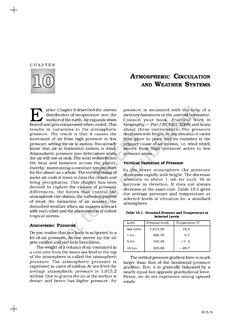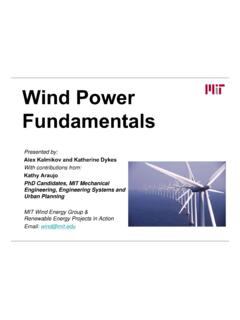Transcription of Cover picture: Irrawaddy Delta, Myanmar - September 2008
1 Copies of FAO publications can be requested from: Cover picture: Irrawaddy Delta, Myanmar - September 2008( Swiatek Wojtkowiak)SALES AND MARKETING GROUPI nformation DivisionFood and Agriculture Organization of the United Nations Viale delle Terme di Caracalla00100 Rome, ItalyE-mail: (+39) 06 57053360 Web site: change, water and food securitybyHugh TurralFAO consultantJacob Burke and Jean-Marc Faur sFAO Land and Water Division FOOD AND AGRICULTURE ORGANIZATION OF THE UNITED NATIONSRome, 2011 FAOWATERREPORTS36 The designations employed and the presentation of material in this information product do not imply the expression of any opinion whatsoever on the part of the Food and Agriculture Organization of the United Nations (FAO) concerning the legal or development status of any country, territory, city or area or of its authorities, or concerning the delimitation of its frontiers or boundaries.
2 The mention of specific companies or products of manufacturers, whether or not these have been patented, does not imply that these have been endorsed or recommended by FAO in preference to others of a similar nature that are not 978-92-5- All rights reserved. FAO encourages reproduction and dissemination of material in this information product. Non-commercial uses will be authorized free of charge, upon request. Reproduction for resale or other commercial purposes, including educational purposes, may incur fees. Applications for permission to reproduce or disseminate FAO copyright materials, and all queries concerning rights and licences, should be addressed by e-mail to or to the Chief, Publishing Policy and Support Branch, Office of Knowledge Exchange, Research and Extension, FAO, Viale delle Terme di Caracalla, 00153 Rome, Italy.
3 FAO 201 iiiPrefaceUnder the IPCC emissions scenarios, higher temperatures are projected to affect all aspects of the hydrological cycle. More frequent and severe droughts and floods are already apparent, and their impact increases as a growing population becomes more dependent upon a set of atmospheric and hydrological circulations. Climate change will impact the extent and productivity of both irrigated and rainfed agriculture across the globe. Reductions in river runoff and aquifer recharge are expected in the Mediterranean basin and in the semi-arid areas of the Americas, Australia and southern Africa, affecting water availability in regions that are already water-stressed. In Asia, the large contiguous areas of irrigated land that rely on snowmelt and high mountain glaciers for water will be affected by changes in runoff patterns, while highly populated deltas are at risk from a combination of reduced inflows, increased salinity and rising sea levels.
4 Everywhere, rising temperatures will translate into increased crop water demand. Both the livelihoods of rural communities and the food security of a predominantly urban population are therefore at risk from water-related impacts linked primarily to climate variability. The rural poor, who are the most vulnerable, are likely to be disproportionately adaptation measures that deal with climate variability and build upon improved land and water management practices have the potential to create resilience to climate change and to enhance water security. They imply a good understanding of the impact of climate change on available water resources and on agricultural systems, and a set of policy choices, and investments and managerial changes to address report summarizes current knowledge of the anticipated impacts of climate change on water availability for agriculture.
5 The implications for local and national food security are examined; and the methods and approaches to assess climate change impacts on water and agriculture are discussed. The report emphasizes the need for a closer alignment between water and agricultural policies and makes the case for immediate implementation of no-regrets strategies which have both positive development outcomes and make agricultural systems resilient to future impacts. It is hoped that policy makers and planners will find in this report the elements of information and guidance that are needed to assess and respond to the challenge that climate change is expected to impose on agricultural water management and food M llerAssistant Director-GeneralNatural Resources Management and Environment DepartmentivAcknowledgementsThis report was prepared by Hugh Turral, FAO consultant, in collaboration with Jacob Burke and Jean-Marc Faur s, from the FAO Land and Water Division.
6 It has benefited substantially from inputs obtained during the Expert Consultation on Climate Change, Water and Food Security organized by FAO in February 2008, in preparation for the High-Level Conference on World Food Security: the Challenges of Climate Change and Bioenergy, held in Rome, Italy, in June 2008. Participants in the Expert Consultation were: Petra D ll (University of Frankfurt-Main), Rachid Doukkali (Morocco), Ashley Halls (Mekong River Commission), Bertjan Heij (The Netherlands), Erda Lin (China), Festus Luboyera (UN-FCCC), David Molden (IWMI), Claudia Ringler (IFPRI), Mahendra Shah (IIASA), Mark Svendsen (USA), Marja-Liisa Tapio-Bistr m (Finland), Francesco Tubiello (Columbia University), and Avinash Tyagi (WMO). FAO participants in the Expert Consultation were Abdelkader Allali, Rosalud Delarosa, Thierry Facon, Karen Frenken, Theodor Friedrich, Aruna Gujral, Thomas Hofer, Jippe Hoogeveen, John Jorgensen, Marketta Juppi, Amir Kassam, Sasha Koo-Oshima, Parviz Koohafkan, Johan Kuylenstierna, Nadia Scialabba, Reuben Sessa and Pasquale Steduto.
7 VPreface iiiAcknowledgements ivList of figures ixList of tables xList of boxes xList of acronyms and abbreviations xiExecutive summary xv1. Introduction Overview Trends versus predictions 32. Setting the scene Water, food security and environment IPCC 4th Assessment and the Stern Review The IPCC 4th Assessment and associated analysis Climate versus weather the downscaling problem The agricultural implications of the IPCC Working Group I report (Physical Science) Broad regional impacts food security and climate change The agricultural implications of the IPCC Working Group II report (Adaptation) The agricultural implications of the IPCC Working Group III report (Mitigation)
8 The Stern Review Agricultural systems dependent on water management Rainfed agriculture Irrigated agriculture Inland fisheries and aquaculture Livestock grazing and fodder production Forested land Economic competition for water, climate change and the challenge for water allocation The pace of agricultural change and climate change projections 293. The baseline and trends in agricultural water demand Agricultural projections to 2030 and the associated demand for water Global analysis Regional analysis Emerging trends in agricultural water management Anticipated trends in agricultural water management Trends without climate change Analysis of economic drivers and future investments 414. Specific climate change impacts related to agricultural water management Introduction Predictive modeling and its limitations in determining agricultural impact Impacts on nations or river basins?
9 Principal climate change drivers in agriculture Overall impacts on crop production Direct effects of temperature and changes in precipitation Carbon dioxide fertilization of crops Pests and diseases Impacts on water supply and demand a global picture Overall water supply impacts Groundwater Implications for water institutions Regional impacts Impacts at river basin level: systemic considerations Introduction Glaciers and runoff Arid basins Recycling water Land-use change in river basins afforestation and sediment management Basins with increasing runoff managing deltas The susceptibility of wetlands to climate change A basin example Food security and environment linkages Climate change impact typology Summary: the combined impacts positive and negative 755.
10 Prospects for adaptation Introduction On -farm adaptation Crop selection and crop calendar Farm and crop management fertilizer management Water management on farm Irrigation technologies on farm Depletion accounting Flood protection and erosion Commercial agriculture Adaptation at irrigation system level Introduction Water allocation System performance Cropping patterns and calendars Conjunctive use of surface water and groundwater Irrigation policy measures Adaptation at river basin and national levels Irrigation sector policy Coping with droughts Coping with flooding; structural and non-structural interventions Managing aquifer recharge Assessment of adaptation options to ensure irrigation supply security Adaptive capacity in agricultural water management policies, institutions and the structure of the sub-sector Mechanisms for allocation National food policy issues Institutions Long-term investment implications for agricultural water management 1156.











